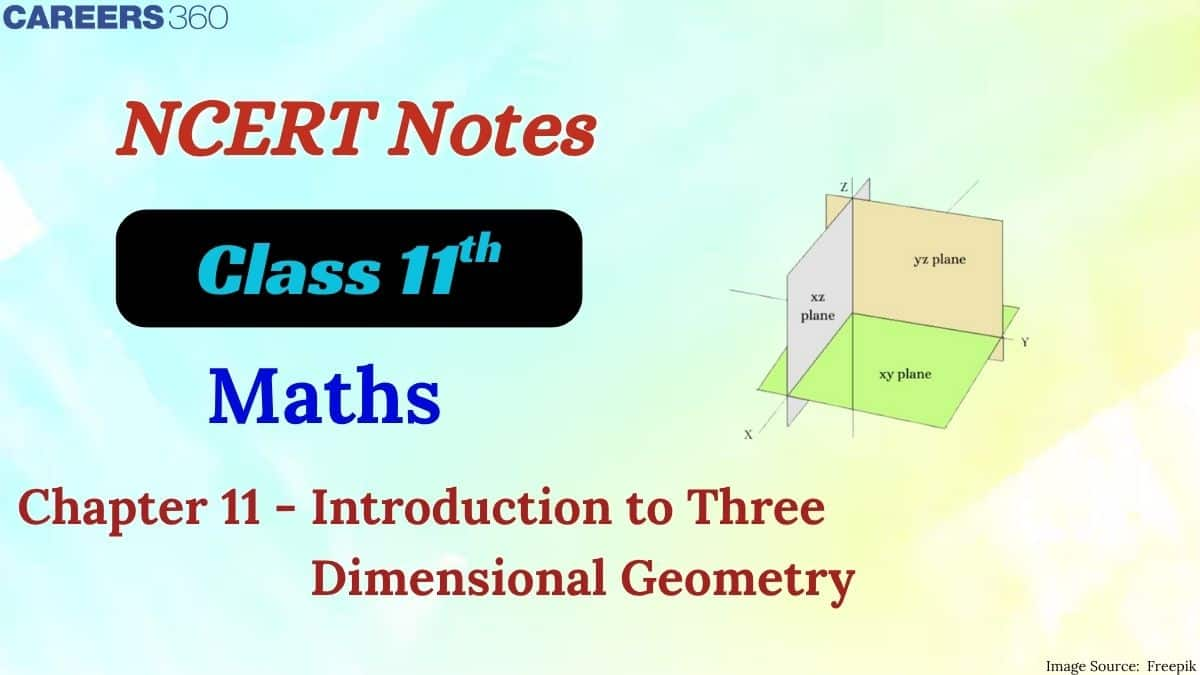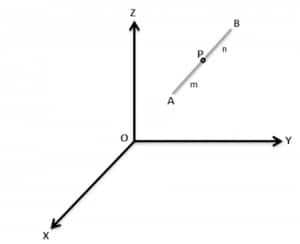Introduction To Three Dimensional Geometry Class 11th Notes - Free NCERT Class 11 Maths Chapter 12 notes - Download PDF
Have you ever wondered how large skyscrapers are designed or how the GPS tells us about our exact locations every time? To find the answer, we have to study three-dimensional geometry, which goes beyond our understanding of two-dimensional geometry to include the X, Y, and Z coordinate axes. The chapter Introduction to Three-Dimensional Geometry contains the concepts of Coordinate Axes and Coordinate Planes in Three-Dimensional Space, Coordinates of a Point in Space, Distance between Two Points and its formula, and many more. These NCERT notes will help the students grasp more advanced geometry concepts easily and enhance their problem-solving ability in real-world applications.
This Story also Contains
- Class 11 Introduction to Three Dimensional Geometry Notes PDF – Download Free Study Material
- Introduction To Three Dimensional Geometry Class 11 Notes
- How to Use the Introduction to Three Dimensional Geometry Class 11 Notes Effectively?
- Introduction to Three Dimensional Geometry Class 11 Notes: Previous Year Question and Answer
- Importance of NCERT Class 11 Maths Chapter 11 Notes
- NCERT Class 11 Maths Notes – Chapter-Wise Links

These NCERT notes for Class 11 Maths offer well-structured NCERT notes to help students easily grasp the concepts of three-dimensional geometry. Students who want to revise the key topics of three-dimensional geometry quickly will find this article very useful. It will also significantly improve students' exam preparation. These NCERT Class 11 Maths Chapter 11 notes on Introduction to Three-Dimensional Geometry are prepared by subject matter experts of Careers360 following the latest NCERT syllabus, ensuring that students can grasp the basic concepts effectively. Check this NCERT article for complete syllabus coverage along with NCERT Books, Solutions, Syllabus, and Exemplar Problems with Solutions.
Also, read,
Class 11 Introduction to Three Dimensional Geometry Notes PDF – Download Free Study Material
Students who wish to access the Introduction to Three-Dimensional Geometry Class 11 Maths notes can click on the link below to download the entire notes in PDF.
Introduction To Three Dimensional Geometry Class 11 Notes
Careers360 has prepared these NCERT Class 11 Maths Chapter 11 Notes to make your revision smoother and faster.
Distance Formula
Suppose that there are two points $(x_1,y_1,z_1)$ and $(x_2,y_2,z_2)$ then the distance formula is given as
$d=\sqrt{\left(x_1-x_2\right)^2+\left(y_1-y_2\right)^2+\left(z_1-z_2\right)^2}$
Section Formula
Suppose that there are two points $(x_1,y_1,z_1)$ and $(x_2,y_2,z_2)$ are divided into $m:n$.

The section formula is given as:
$\left(x^{\prime}, y^{\prime}, z^{\prime}\right)=\left(\frac{m x_2+n x_1}{m+n}, \frac{m y_2+n y_1}{m+n}, \frac{m z_2+n z_1}{m+n}\right)$
System Of Planes
An equation of a plane contains three independent constants; as such, a plane is uniquely determined by three independent conditions. If we consider a plane satisfying just two given conditions, its equation will contain one arbitrary constant. If we consider a plane satisfying one given condition, its equation will contain two arbitrary constants.
We give below the equations of some well-known systems of planes:
The equation $ax + by + cz + k = 0$ represents a system of planes parallel to the plane $ax + by + cz + d = 0$,
where $d$ and $k$ are parameters.
The equation $ax + by + cz + k = 0$ represents a system of planes perpendicular to the line $\frac{x}{a} = \frac{y}{b} = \frac{z}{c}$.
The equation $a_1x + b_1y + c_1z + d_1 + λ(a_2x + b_2y + c_2z + d_2)= 0$ is a system of planes passing through the intersection of the planes
$a_1x + b_1y + c_1z + d_1 = 0$ and $a_2x + b_2y + c_2z + d_2 = 0$,
where $λ$ is a parameter.
Angle Between Two Planes
Let there be two planes
$a_1x + b_1y + c_1z + d_1 = 0$ and $a_2x + b_2y + c_2z + d_2 = 0$
Then the angle between is given as
$\cos\theta=\left|\frac{a_1a_2+b_1b_2+c_1c_2}{\sqrt{a_1^2+b_1^2+c_1^2} \sqrt{a_2^2+b_2^2+c_2^2}}\right|$
The Symmetrical Form Of The Equation Of A Line
If a straight line passes through a given point $(x_1,y_1,z_1)$ and has direction cosines $l, m, n,$ then the coordinates of any point on it satisfy the equations
$\frac{x-x_1}{l}=\frac{y-y_1}{m}=\frac{z-z_1}{n}$
Vector Equations
The parametric vector equation of the line through a point with position vector $a$ and parallel to the vector $b$ is:
$\vec{r}=\overrightarrow{\mathrm{a}}+\lambda \vec{b}$, where $λ$ is a scalar parameter.
How to Use the Introduction to Three Dimensional Geometry Class 11 Notes Effectively?
An Introduction to Three Dimensional Geometry helps us understand how points and distances work in 3D space. In this chapter, we learn about coordinate axes, coordinate planes, coordinates of a point, and the distance between two points. We can use Class 11 Maths chapter 11 notes to understand space geometry step by step. Here are some more points on how these notes are important.
- First, clearly understand coordinate axes and planes before moving to questions on points and distances.
- Practice numericals from the coordinates of a point and the distance formula to avoid mistakes.
- Revise formulas and solved examples from the NCERT Class 11 Maths chapter 11 notes before tests and exams.
- This chapter is very useful in Class 12, vectors, and 3D geometry, so learning it well now will help you later.
Introduction to Three Dimensional Geometry Class 11 Notes: Previous Year Question and Answer
Given below are selected previous year question answers for NCERT Class 11 Maths Chapter 11 Introduction to Three Dimensional Geometry, collected from various examinations.
Question 1:
Show that the three points A (2, 3, 4), B (–1, 2, – 3) and C (– 4, 1, – 10) are collinear and find the ratio in which C divides AB.
Solution:
Given:
A(2,3,4), B(-1,2,-3) & C(-4,1,-10)
Now,
AB = $\sqrt{(2+1)^{2}+(3-2)^{2}+(4+3)^{2} }$
= $\sqrt{9+1+49 }$ = $\sqrt{59 }$
BC = $\sqrt{(-1+4)^{2}+(2-1)^{2}+(-3+10)^{2}}$
= $\sqrt{9+1+49 }$ = $\sqrt{59 }$
AC = $\sqrt{(2+4)^{2}+(3-1)^{2}+(4+10)^{2} }$
= $\sqrt{36+4+196 }$ = $2\sqrt{59}$
Now, AB + BC = $\sqrt{59}+\sqrt{59}$
= $2\sqrt{59}$
= AC
Thus, A, B & C are collinear.AC:BC = $2\sqrt{59}:\sqrt{59}$ = 2:1
Thus, C divides AB externally in the ratio 2:1.
Question 2:
What is the length of the foot of the perpendicular drawn from the point P (3, 4, 5) on the y-axis
A. $\sqrt{41}$
B. $\sqrt{34}$
C. 5
D. None of these
Solution:
The answer is the option (b)$\sqrt{ 34}$
On y-axis, x = z = 0
Thus, A = (0,4,0)
Thus, PA
= $\sqrt{ (0-3)^{2}+(4-4)^{2}+(0-5)^{2} }$
= $\sqrt{ 9+0+25 }$
= $\sqrt{ 34 }$
Hence, the correct answer is option B.
Question 3:
The distance of the point (3, 4, 5) from the origin (0, 0, 0) is
A. $\sqrt{50}$
B. 3
C. 4
D. 5
Solution:
The answer is the option (a) $\sqrt{50}$
Given: P(3,4,5) & O(0,0,0)
Thus, OP
= $\sqrt{(0-3)^{2}+(0-4)^2+(0-5)^{2} }$
= $\sqrt{9+16+25}$
= $\sqrt{50}$
Hence, the correct answer is option A.
Importance of NCERT Class 11 Maths Chapter 11 Notes
NCERT Class 11 Maths Chapter 11 Notes play a vital role in helping students grasp the core concepts of the chapter easily and effectively, so that they can remember these concepts for a long time. Some important points of these notes are:
- Effective Revision: These notes provide a detailed overview of all the important theorems and formulas, so that students can revise the chapter quickly and effectively.
- Clear Concepts: With these well-prepared notes, students can understand the basic concepts effectively. Also, these notes will help the students remember the key concepts by breaking down complex topics into simpler and easier-to-understand points.
- Time Saving: Students can look to save time by going through these notes instead of reading the whole lengthy chapter.
- Exam Ready Preparation: These notes also highlight the relevant content for various exams, so that students can get the last-minute guidance for exams.
NCERT Class 11 Maths Notes – Chapter-Wise Links
We at Careers360 compiled all the NCERT class 11 Maths notes in one place for easy student reference. The following links will allow you to access them.
|
NCERT Class 11 Maths Chapter 2 Relations and Functions Notes |
|
NCERT Class 11 Maths Chapter 3 Trigonometric Functions Notes |
|
NCERT Class 11 Maths Chapter 4 Complex Numbers and Quadratic Equations Notes |
|
NCERT Class 11 Maths Chapter 6 Permutation and Combinations Notes |
|
NCERT Class 11 Maths Chapter 11 Introduction to Three-Dimensional Geometry Notes |
|
NCERT Class 11 Maths Chapter 12 Limits and Derivatives Notes |
Subject-Wise NCERT Notes
Given below are some subject-wise links for the NCERT Notes for class 11.
Subject-Wise NCERT Exemplar Solutions
After finishing the textbook exercises, students can use the following links to check the NCERT exemplar solutions for a better understanding of the concepts.
- NCERT Exemplar Class 11 Solutions
- NCERT Exemplar Class 11 Maths
- NCERT Exemplar Class 11 Physics
- NCERT Exemplar Class 11 Chemistry
- NCERT Exemplar Class 11 Biology
Subject-Wise NCERT Solutions
Students can also check these well-structured, subject-wise solutions.
- NCERT Solutions for Class 11 Mathematics
- NCERT Solutions for Class 11 Chemistry
- NCERT Solutions for Class 11 Physics
- NCERT Solutions for Class 11 Biology
NCERT Books and NCERT Syllabus
Students should always analyse the latest syllabus before making a study routine. The following links will help them check the syllabus and access some reference books.
Frequently Asked Questions (FAQs)
Three Dimensional Geometry (3D Geometry) deals with the study of points, lines, and shapes in space that have three coordinates — x, y, and z.
The three axes are the x-axis, y-axis, and z-axis, which are mutually perpendicular to each other and intersect at the origin.
The origin is the point where all three axes intersect, and its coordinates are (0, 0, 0).
Direction Cosines: Cosines of the angles a line makes with the x, y, and z axes.
Direction Ratios: Proportional values representing the direction of a line in 3D space.
Students can download the Free NCERT Class 11 Maths Chapter 11 Notes PDF Introduction to Three Dimensional Geometry from the official Careers360 website.
Courses After 12th
Applications for Admissions are open.
As per latest syllabus. Physics formulas, equations, & laws of class 11 & 12th chapters
JEE Main Important Chemistry formulas
Get nowAs per latest syllabus. Chemistry formulas, equations, & laws of class 11 & 12th chapters
JEE Main high scoring chapters and topics
Get nowAs per latest 2024 syllabus. Study 40% syllabus and score upto 100% marks in JEE
JEE Main Important Mathematics Formulas
Get nowAs per latest syllabus. Maths formulas, equations, & theorems of class 11 & 12th chapters
